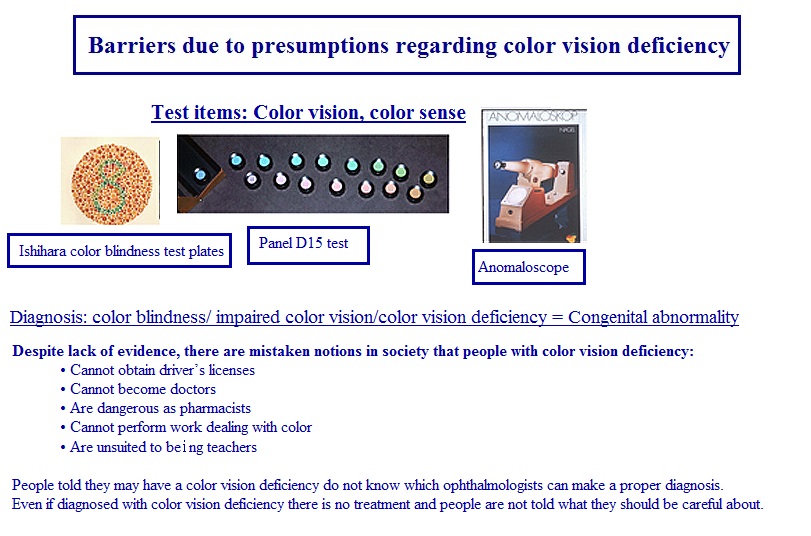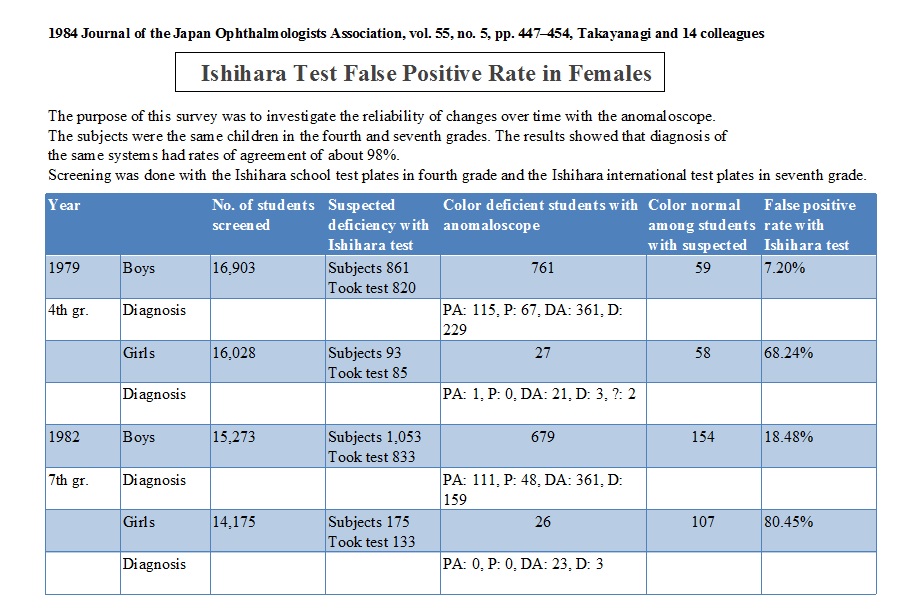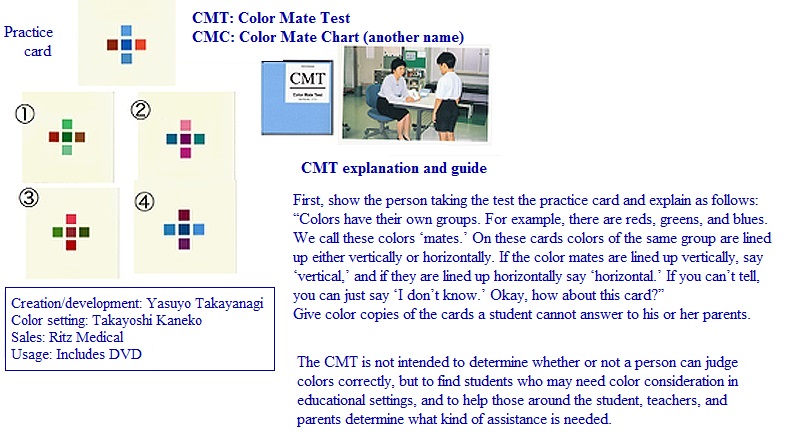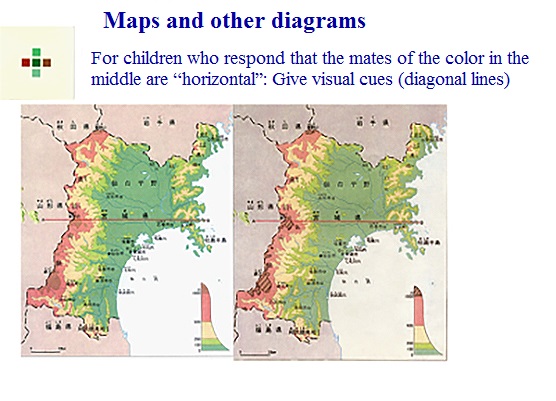About color vision
- What is the purpose of health checks?
- What is the essence of the color vision problem in Japan?
- Changes in who undergoes color vision tests in school health checks
- Who performs the color vision test in schools?
- The start of my research into color vision
- Use of the general Ishihara color vision test for schools
- Presence or absence of certain genes
- Stories of lost confidence and genetic problems by people with color vision deficiency from their experiences with the Ishihara test
- Barriers due to presumptions regarding color vision deficiency
- Problems with the Ishihara test
- Reconsidering the color vision test included in general health checks
- Tests of how elementary school students who need special consideration see color
- It is not necessary to know whether there are any children with color special vision in a class
- It is not necessary to know whether there are any children with color special vision in a class
- The Ministry of Education, Culture, Sports, Science and Technology has not issued any directions for school nurses. Have students consult a doctor
- Keep results of Color Mate Test in health records
- How to tell people about color special vision
- Employment rejection in schools and companies
- Follow-up for people with color vision deficiency
What is the purpose of health checks?
Everything in a health check must have a purpose.
If something is “abnormal,” where is the abnormality and how is it abnormal? What kinds of problems will the individual have because of the abnormality, and what can be done to avoid those problems? What kind of problems will occur in the future, and what should be done to circumvent them? To be qualified to perform health tests, a person must be able to answer all of these questions.
What is the essence of the color vision problem in Japan?
There are problems related to color vision in Japan because Japanese society as a whole, Japanese doctors, and Japanese ophthalmologists lack awareness of the rights of Japanese citizens and do not recognize the extent to which they have been brainwashed with regard to color vision.
Changes in who undergoes color vision tests in school health checks
Neither the Ministry of Education, Culture, Sports, Science and Technology nor the Japan Ophthalmologists Association have known how to deal with children who fail the color vision test, and so the children the test is given to seems to change arbitrarily.
1918 (96 years ago) A highly precise test was developed for men. It was to be used in the physical examination of military conscripts. It is an excellent test for men, but even today no investigations have been done on whether or not it can be used for women. At the time the test was made, very few women worked in society outside the home.
The School Health Act was enacted and every child was tested for color blindness each year (11 years)
The color vision test was given to first, third, and sixth grade elementary school students and first year high school students (tenth grade) (4 years)
1973First and fourth grade elementary school students, first year junior high school students, first year high school students, first and fourth year vocational high school students (5 years)
1978First grade elementary school students who are present only (17 years)
Fourth grade elementary school students; one time only (8 years)
2002The Nagoya City Board of Education removed the color vision test from the regular school health checkup
2003The color vision test was removed from the regular school health checkup in the School Health Act
2014The Ministry of Education, Culture, Sports, Science and Technology issued a notice construed as positively recommending color vision tests
Who performs the color vision test in schools?
I do not know who gave the test before the school nurse system was introduced, but since then the test has usually been given by school nurses. However, I have heard of cases in which teachers or even children in upper grades and class officers also gave the tests. Informed consent is completely ignored and people with color vision deficiency who had to go through this have told me it was pure agony.
The start of my research into color vision
When I became a school doctor in 1973, a school nurse told me that she did not want to give the color vision test because it leads to “boys being denied opportunities for further education, girls losing opportunities for marriage talks, and tears and grief in parents.” That is when I began to survey school entrance examination guidelines and employment restrictions.
Use of the general Ishihara color vision test for schools
Entrance examination guidelines for vocational high schools and university departments of science, medicine, engineering and education often included a statement such as, “People with color vision deficiency are ineligible regardless of academic record.” When I then asked the university president or admissions officer the reason for these restrictions, they said they would look into it. The number of universities with restrictions decreased each year, and over about five years all universities but three stopped mentioning color vision.

Presence or absence of certain genes
The problem in Japan is that greater emphasis has been placed on whether or not a person has certain color vision genes that are expressed in a sex-linked recessive inheritance pattern and the Drosophila fly that appears in biology textbooks than in evaluations of actual color discrimination ability. No one in the world knows how colors are seen by individual people with color vision deficiency. Detection of gene carriers is also difficult.
The color vision test does nothing but identify people who do not perform normally on the test; it offers no follow-up measures whatsoever. The Ministry of Education, Culture, Sports, Science and Technology does not seem to notice that this test is in the same category as tests measuring individual differences in body height or weight. It also does not seem to notice that informed consent is needed.
Stories of lost confidence and genetic problems by people with color vision deficiency from their experiences with the Ishihara test
“I have impaired color vision (anomalous trichromacy). My daughter is going to be married, and I wonder if I should confess this to her.”
“My husband is colorblind and my eldest daughter is married and has just had a baby. What should I do about marriage talks for my younger daughter?”
“I found out I had color vision deficiency in the health check in grade school. When my mother became pregnant with another child, she aborted it.”
“I felt bitterness toward my mother for giving birth to me colorblind, and treated her very badly.”
“I married into a family of doctors and when we found out from a school health check that my oldest son was colorblind, my husband divorced me.”
Barriers due to presumptions regarding color vision deficiency
Health examinations include color vision and color sense items, and screening for color vision deficiency is done using the color vision test plates kept in all schools, public health centers, and company healthcare offices. This screening identifies people suspected of having color vision deficiency. It is not a medical diagnosis, but it has come to be seen as if it were.
For a medical diagnosis, a panel D15 test is needed to determine the severity and type, but fewer than 10% of medical institutions have this test.
For an even more reliable diagnosis, an anomaloscope is used. However, in a 1996 survey by the Japan Ophthalmologists Association only 0.1% of ophthalmological institutions had this instrument. In these circumstances, any diagnosis of color blindness, impaired color vision, or color vision deficiency has come to be equated with congenital color vision deficiency, and despite the lack of supporting evidence the mistaken notions have been generally accepted in society that these people cannot obtain a driver’s license, cannot become doctors, are dangerous as pharmacists, cannot perform work dealing with color, are unsuitable as teachers and much more.

Police departments and the Self-Defense Force have stopped using the Ishihara color vision test, but have replaced it with the panel D15 test as the standard for determining whether individuals will have problems in performing their duties or tasks. Applicants may pass the first and second tests for joining the police force or Self-Defense Force, but still be told to bring a medical certificate from an ophthalmologist after being tested with the panel D15 test. However, this shows considerable thoughtlessness and is a real burden on these applicants as most people do not know which ophthalmologists have the panel D15 test.
People who are told that they may have a color vision deficiency do not know which ophthalmologists can make a proper diagnosis. Even if they are diagnosed with color vision deficiency, there is no treatment and people are not told what they should be careful about.
Problems with the Ishihara test
・A person’s color discrimination ability cannot be understood from the Ishihara test.
・The false positive rate with the Ishihara test is low for males, but is 70–80% for females. In 1984 the Journal of the Japan Ophthalmologists Association carried an article on the false positive rate of the Ishihara test in females (vol. 55, no. 5, pp. 447–454). Following a diagnosis of color vision deficiency, education and employment become difficult for males, while marriage becomes difficult for females. A test with such a high false positive rate should not be used in school health checks for public health. Rather, it would be better for individuals who feel the need to go to an ophthalmological specialist for examination and testing, where they can receive a full and satisfactory explanation of their condition.
Reconsidering the color vision test included in general health checks
The following three laws were amended in a reconsideration of color vision tests.
In 1995 the Ministry of Education, Science and Culture partially revised the School Health Act to identify children who need special consideration in learning and to provide appropriate follow-up measures. Children who did not need special consideration would not be considered to have an impairment. In 2001 the Ministry of Health, Labour and Welfare revised the Industrial Safety and Health Act to abolish color vision tests in hiring. In 2003 the Ministry of Education, Science and Culture again revised the School Health Act and eliminated color vision tests from regular health checks. In 2004 the Ministry of Land, Infrastructure, Transport and Tourism revised the Seaman and Small Craft Operator Act to abolish ophthalmological color vision tests and conduct screening with a test of ability to differentiate between different color lights. People who failed this screening test are given a newly established test to discriminate three colors. If they pass this test they can take the examination for a daytime license.

Tests of how elementary school students who need special consideration see color
At the time of the 1995 revision to the School Health Act, I worked together with color psychologist Takayoshi Kaneko, Professor Emeritus at Tsukuba University, to develop the Color Mate Test (CMT). This is a test to see which color combinations are difficult for the 2.2% of boys who have trouble differentiating certain colors when they are combined.
The purpose of the test is not to distinguish good or bad; rather, it was developed as a tool for remedial action. The Japan Ergonomics Society has praised it in terms of universal design as a practical test for determining how help can be provided amid the great diversity of human characteristics.


On maps with colors that are difficult to differentiate, diagonal lines or other non-color visual cues are helpful.
It is not necessary to know whether there are any children with color special vision in a class
Rather than finding out who has color special vision and taking special measures for them, please just use white or yellow chalk on the blackboard (greenboard), not red, so that the writing is easy for everyone to see all the time. All students will be able to see more easily. If someone asks, test them with the Color Mate Chart (CMC; formerly CMT). Children with color special vision for whom follow-up measures are taken have superior brightness discrimination ability.
Test charts used by school nurses
・ School nurses do not need to give color vision tests, as the Ministry of Education, Culture, Sports, Science and Technology does not tell schools to give a color vision test in school health checks. “If it is desired” means that a test can be given to children who feel difficulty in discriminating colors, or whose parents feel their child may be having difficulty, and who want the test.
・What people want to know is what colors an individual has difficulty telling apart, not whether or not a person has a congenital abnormality
・ I think the Color Mate Chart (CMC) (Color Mate Test (CMT)) is the best for this. The CMC is not a test used by doctors, but rather something that teachers can use to understand color difficulties in students.
・Pseudoisochromatic plates (both the Ishihara test and standard pseudoisochromatic plates) are equivalent to genetic tests and should not be used. School nurses do not have a responsibility to do this. Color vision test plates are tests to be used by doctors.
The Ministry of Education, Culture, Sports, Science and Technology has not issued any directions for school nurses. Have students consult a doctor
・Pseudoisochromatic plates do not give any information on which colors an individual will have difficulty differentiating, and so are meaningless as a test in the sense of showing whether a child’s color special vision will be a hindrance to learning.
・Job aptitude cannot be judged from conventional color vision tests, and so color vision tests for purposes of education or employment are meaningless. No color vision test for occupational aptitude exists anywhere in the world.
・I believe it is the duty of education to foster people who will develop their strengths and contribute to future society, no matter what obstacles or impediments they face.
Keep results of Color Mate Test in health records
・ A good educational environment cannot be developed if visual impairments, hearing impairments, physical impairments, learning impairments, color special vision, or other matters are hidden.
・ It is important to always write these things on health records and note any special measures that have been taken, and pass these records on to the next person.
・Today, as the special needs education and certified school attendee systems are decreasing and we are moving closer to inclusive education, a lack of records on student characteristics makes it very difficult to know how to assist individual students. Although this is personal information, it is needed for true education. Better education can be achieved when the results of tests like these are shared among teachers with a common understanding.
How to tell people about color special vision
・The Color Mate Charts identify the characteristic colors that each student with color special vision has difficulty differentiating, from among 100 colors used in school. Color copies of the charts that a student cannot tell apart may be used to inform the students, parents and teachers about the student’s color vision difficulty.
・It is difficult to know how children diagnosed with color vision deficiency by an ophthalmologist see colors. The CMC may be useful here. If a student can tell apart the colors on all the charts, it is unlikely that he or she will have difficulty with color in school education. If there are charts that a student cannot answer, the color combination on that chart should be kept in mind.
Employment rejection in schools and companies
There are no cases when a color vision test is needed for a school entrance examination, and no schools that refuse entry based on color vision.
In companies, color vision tests have basically been abolished in hiring based on the Industrial Safety and Health Act, and so applicants should not be refused based on color vision.
・While there are no restrictions for a company as a whole, there are restrictions within companies. Just as a person with poor language skills would not be hired for a job that requires good language ability, it stands to reason that a person with color vision deficiency would not be hired for a job that requires fine color discrimination.
・A person should be aware of his or her color vision characteristics and select a job that he or she feels comfortable doing. It may also be a good idea to find a coworker or other person who will help if a problem is encountered in color selection.
Even for people whose color vision test is normal, becoming qualified as a pilot is very difficult.
・We do not know what kinds of abilities will come out in ourselves, so it is a good for people idea try many things in school and finally take responsibility themselves for choosing a suitable profession.
Follow-up for people with color vision deficiency
・ School nurses should advise teachers to use visual cues other than color for easier differentiation when working with textbooks that contain color combinations identified as difficult for a student on the CMC.
・School nurses should follow up by telling teachers to contact them any time if there is a problem.
・Families should encourage students with a color vision deficiency to build on his or her strengths and move forward confidently, without letting heredity hold them back.
・Medical institutions should use special care in testing females. A proper diagnosis is difficult even with an anomaloscope, and it is better to refer patients to a color vision specialist than to make a cursory diagnosis oneself.










